Camping Safari in South Africa, Namibia, Botswana and Zimbabwe
Spectacular Wildlife and Natural Wonders
Article and photos by Lies Ouwerkerk
Senior Contributing Editor
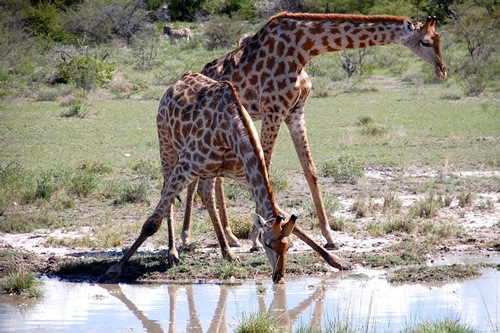 |
| Giraffes at waterhole in Etosha National Park, Namibia, seen on a camping safari. |
Orange River
Through the mountain desert of Ai-Ais Richtersveld Transfrontier Park — tucked away on the Atlantic Coast in the far northwest corner of South Africa — runs the mighty Orange River, the longest river in South Africa. On its riverbank, close to the border of Namibia, we enjoy the first camping stop of our packed 20-day safari trip from Cape Town to Victoria Falls.
It feels like luxury camping, with a staff of three (driver, tour guide, and cook) unloading the truck, setting up our igloo tents, and preparing a braai (BBQ), while we 13 travelers — hailing from Great Britain, the U.S., and Canada — are sent away to lounge lazily on the deck of the bush camp’s restaurant, soak in the superb views of the wilderness around us, spot birds like the jackal buzzard and the African fish eagle, and watch the occasional canoe drift by against the splendid light of the setting sun.
Fish River Canyon
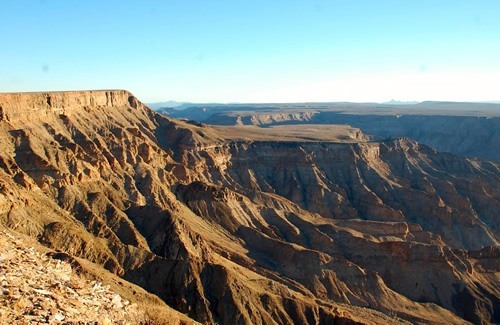 |
| Fish River Canyon, South Africa. |
Next morning we have some time to try out the canoes ourselves and maneuver them through the shallow rapids nearby, but then it’s back into the truck, and up to the impressive Fish River Canyon, situated in the far South of Namibia along the lower reaches of the Fish River.
The largest in Africa, and second in the world after Arizona’s Grand Canyon, Fish River Canyon was formed an estimated 500 million years ago, when a fracture in the earth created a valley, deepened by moving glaciers in an ice age, and further eroded over successive centuries. Close to our rest camp is the canyon’s main vantage point, where we have a stunning view of the famous Hell’s Bend.
Sossusvlei, Deadvlei, and Sesriem
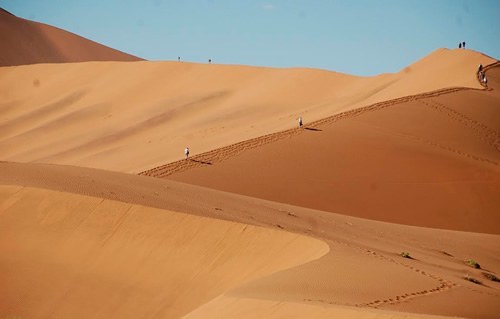 |
| Sossusvlei dunes. |
Climbing "Big Daddy" — one of the world’s biggest and most spectacular sand dunes — and watching from atop the sunrise over the Sossusvlei (meaning: place of no return), is an absolute must!
The sand dunes of this region, seen from above as peaks with multiple arms, have been formed in this star shape by multi-directional winds, which keep the dunes fairly stable. The orange hued sand, originally from the Kalahari Desert, was blown here an estimated five million years ago.
Not far from Sossusvlei you will discover the surrealistic landscape of the Deadvlei, about 900 years ago an oasis with acacia trees, now a graveyard of their remains, scorched by the hot sun. The black skeletons contrast dramatically with the white floor of the clay pan, the orange-red sand of the surrounding dunes (which are the reason the trees were eventually cut off from their survival source, the nearby Tsauchab River), and the hard-blue color of the sky. It is no wonder that this fascinating scenery has been captured on camera by many a photographer, and was used as a backdrop for several motion pictures.
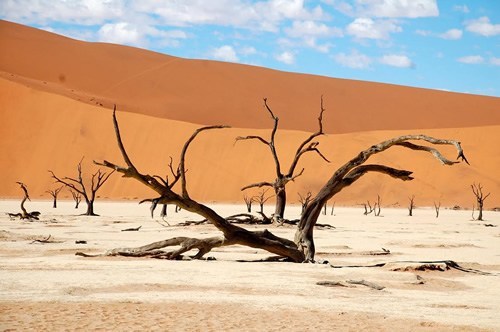 |
| The surrealistic landscape of the Deadvlei. |
Desert-dwelling creatures such as reptiles, beetles, and spiders miraculously survive in this arid and harsh environment by drinking droplets of the occasional morning fog coming in from the Atlantic Ocean. The larger mammals we spot in this area, like the springbok, gemsbok, and black-backed jackal, are excellent desert survivors as well.
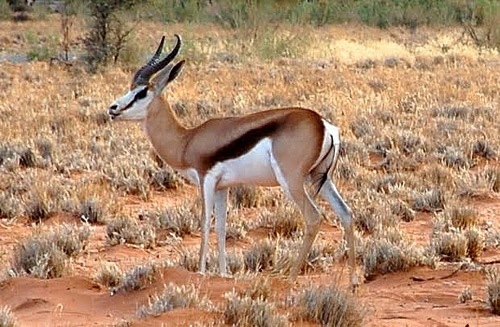 |
| Springbok. |
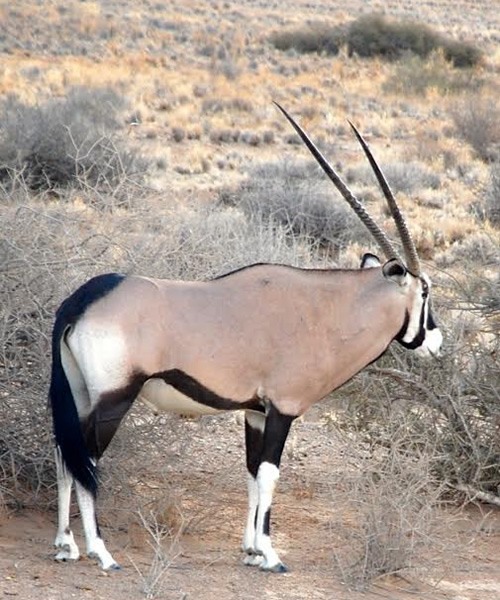 |
| Gemsbok. |
Sesriem Canyon, in close proximity to Sossusvlei and Deadvlei, is one of the few places in the area that does hold water year round. Previous settlers would come here to fill their buckets from the depth with six-knotted belts, called riem in Afrikaans, hence the canyon’s name. While walking over the floor of the canyon, we have to be very cautious, as there are spots where hardly any daylight comes through the narrow opening between the canyon walls.
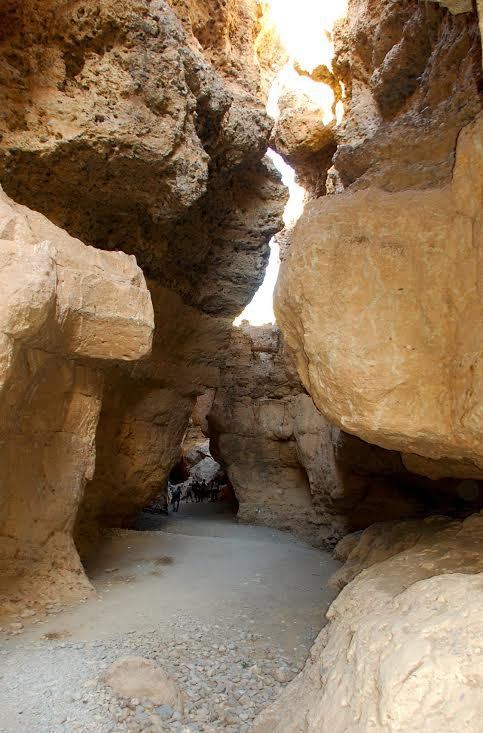 |
| Sesriem Canyon. |
Solitaire
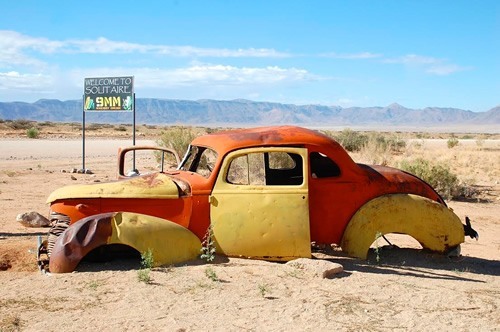 |
| Solitaire. |
While crossing the inhospitable, lunar landscape of the Namib Naukluft National Park, we suddenly bump into a small settlement called Solitaire, the only place between the capital Windhoek, the Sossusvlei, and the Atlantic Ocean where you can stack up on drinks and food, use a toilet, and fill up the gas tank.
In 1948, there was one sole cottage here, belonging to a sheep farmer who eventually established a general store cum post office, bakery, and petrol pump, and gave the place its current name. The Dutch author Ton van der Lee made Solitaire internationally known with an autobiographic novel describing his life here as the third inhabitant during his quest for spirituality and peace in the 90’s.
Currently, Solitaire — situated at the junction of two "main roads" — also has a campsite and motel, and has become a common stopover for not only tourists, but also locals, eager to exchange the latest news and strike up a conversation with those traveling through. As several of them insist that the bakery’s famous apple pie is “the best of whole Namibia,” we succumb to a few for on the road and devour them at a covered rest spot in the desert, watching a herd of zebras coincidentally parading by.
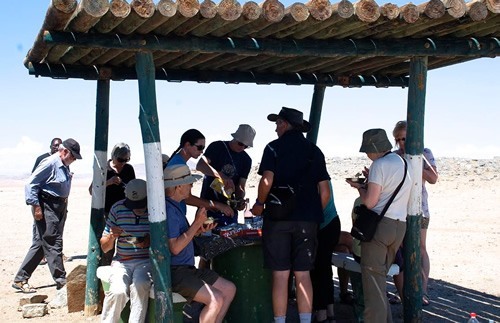 |
| Eating lunch in the desert, with a herd of zebra soon to pass by. |
Swakopmund
After a week of camping, sleeping in a hotel for two nights comes as a welcome break! We have arrived in Swakopmund, a city of about 60,000 inhabitants on the coast of Western Namibia, founded in 1892 as the main harbor for German South-West Africa, as Namibia was then called. The German influence is still very palpable in the colonial architecture of buildings in the downtown area. Unfortunately, fog and lack of sun (at least 180 days a year!) give the place a somewhat gloomy feel.
In 1915, the German army was defeated by South Africa. Under Apartheid, black people were not allowed to live in the center of Swakopmund, so townships were erected at a considerable distance from the city, with separate areas for each tribe, among them the Herero, Damara, Himba, Owambo, and Nama. Although Namibia has been independent from South Africa since 1990, and anyone can now live anywhere, people have become established in their own communities and tend to stay where they are. There are currently far more people living in the townships than in Swakopmund proper. Unfortunately, some still house in informal settlements built of reclaimed garbage from the city’s landfill, without any sanitary facilities.
During a tour through the township of Mondesa, we end up in a tiny food place to eat a traditional meal including wild spinach, mashed beans, and mopane worms. Although westerners may frown upon the consumption of caterpillars, the worms are highly nutritious and a fixed staple of the African cuisine. Fried with onions and tomatoes, the taste comes actually quite close to that of a crunchy barbecued chicken!
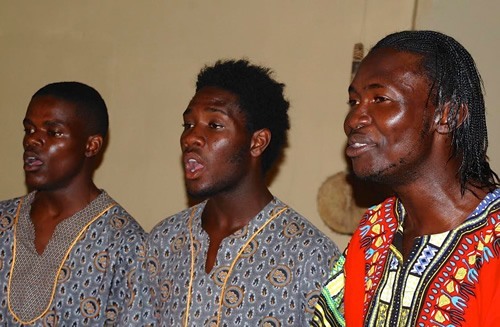 |
| Singing group in Mondesa. |
Game Viewing in National Wildlife Parks
Leaving the coast behind, and en route to Etosha National Park, we visit Twyfelfontein, Namibia’s first UNESCO heritage site since 2007. Here we admire many fascinating rock engravings of animals and geometrical figures (the latter supposedly indicating water sources), some dating back 6,000 years. The paintings are a silent testimony to the earliest inhabitants of the region, the Khoi-San hunters and gatherers or Bushmen, who used this place for worship and shaman rituals.
From here onwards, the focus of the trip will be on game viewing, starting in Etosha National Park with its forest and grassland around a large saltpan, where a plethora of animals congregate around waterholes at different times of the day and night. The wildebeest, impala, zebra, springbok, kudu, giraffe, and elephant become a common sight, and especially the "twitchers" among us marvel at the abundance of flamingos, storks, cranes, secretary birds, grey go away birds, kori bustards, hornbills, and lilac-breasted rollers. More grizzly, however, looks the struggle between a flock of vultures and a family of jackals, over the bloody carcass of a young springbok.
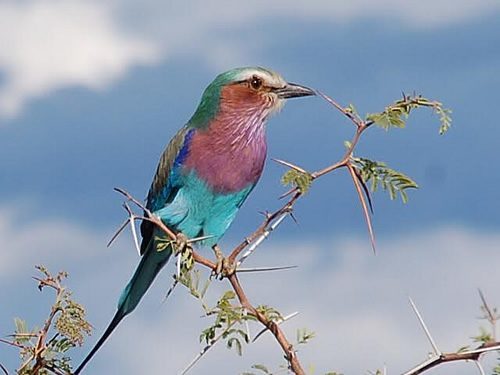 |
| Lilac-breasted roller, the national bird of Botswana. |
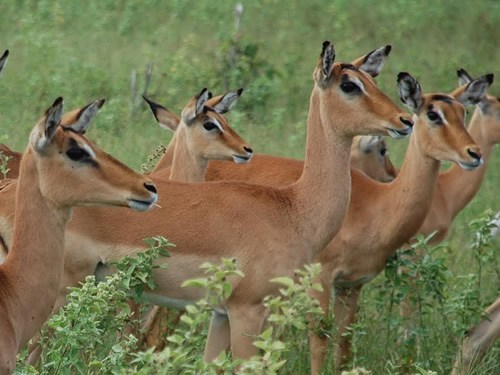 |
| Young impalas. |
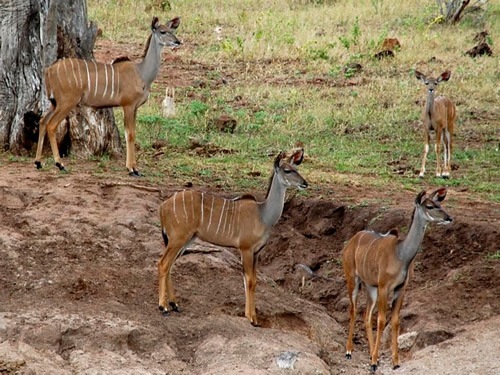 |
| Young kudus. |
One of the waterholes, lit with floodlights at night, is very close to our campsite. While we are wining and dining, our driver keeps an eye on the activity at the waterhole, and indeed comes soon rushing to the camp to announce the arrival of a rhinoceros, considered the most dangerous of the Big Five (the buffalo, elephant, lion, leopard, and rhino are called the Big Five since they were viewed as the most difficult and dangerous animals to hunt on foot by big-game hunters). From several viewing points around the waterhole, we follow, in total silence and breathless, the slow movements of the huge animal. And when the rhino has had enough to drink and has disappeared again into the dark, the spot is soon filled by a troop of lions, whose incessant roaring during the night keeps us aware of their close proximity.
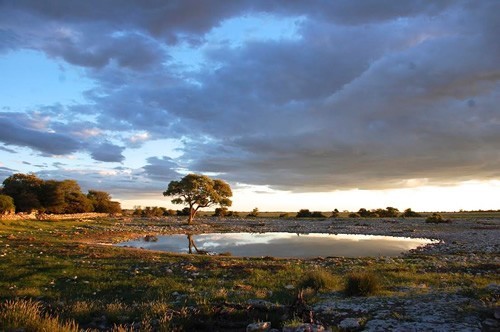 |
| Etosha National Park at Campsite Okaukuejo: waterhole where animals congregate. |
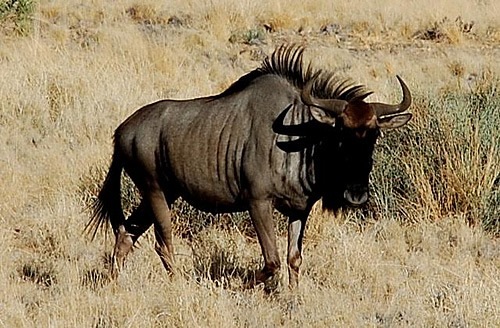 |
| A wildebeest spotted at the Etosha National Park. |
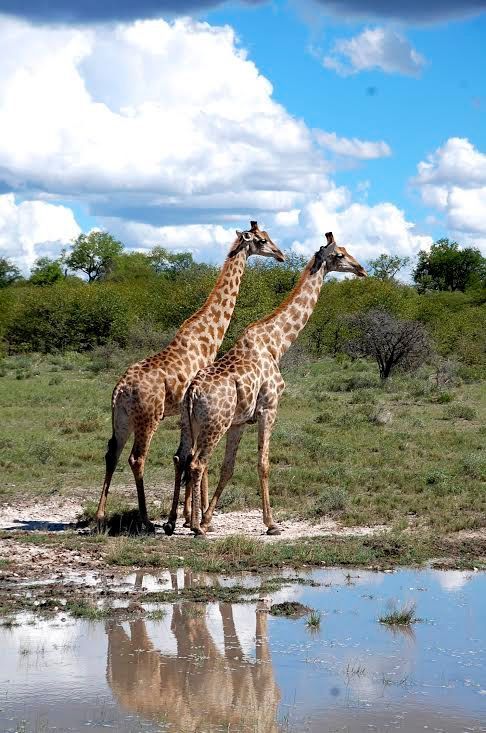 |
| Giraffes at a waterhole in Etosha National Park. |
If that’s not yet enough excitement, we also spot a cheetah during a game drive through the park next day, and get ample opportunity to observe the big cat going about its daily routine, just steps away from our truck.
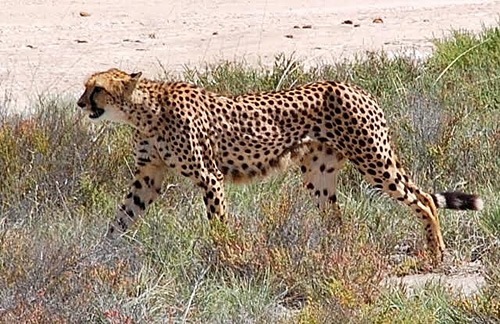 |
| Encounter with a cheetah in Etosha National Park. |
The Okavango Delta, a large inland delta emptying the floodwaters from the remote highlands of Angola into Botswana’s flatland, became in 2014 the 1000th site to be officially inscribed on the Unesco World Heritage List. It is both a permanent and a seasonal home to an enormous variety of wildlife.
We glide through its waterways in traditional mokoros (dugout canoes) and listen to the call of the African fish eagle. The sheer tranquility of the region makes us nearly forget that there are also crocodiles in the shallower areas here.
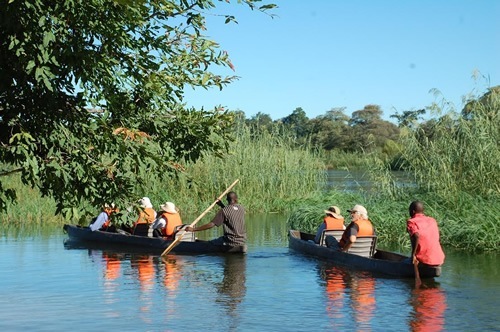 |
| Crossing the Okavango River in a traditional "mokoro." |
A floating game drive on the Chobe River in Botswana’s Chobe National Park makes it possible to watch huge herds of elephants coming to drink or cross the river, and large bloats of hippos moving around in the more swampy areas.
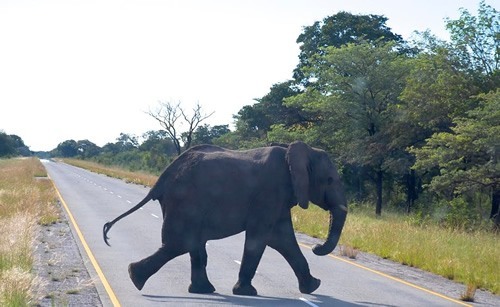 |
| Elephant crossing the road. |
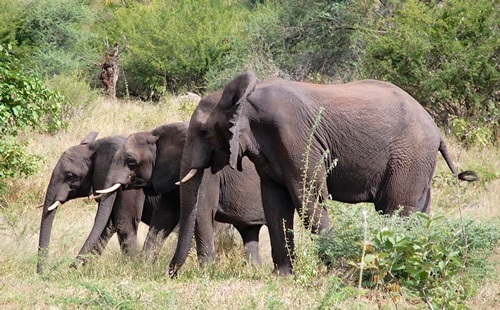 |
| Elephants hanging out. |
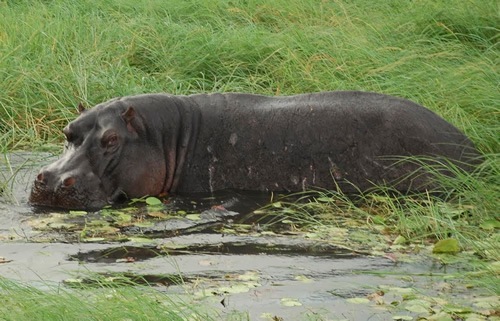 |
| A hippo spotted and who spotted us. |
At night, at the scenic camping of Rainbow River Lodge, on the banks of the Okavango River, there is more water than we had bargained for, though. A humongous downpour accompanied by thunder causes severe leaks in most tents and forces the majority of us to seek refuge in nearby chalets, which in turn fail to be water-resistant as well. Luckily we are spared of more rains until we reach our end destination, Victoria Falls.
Victoria Falls
The loud roar of the Victoria Falls (world’s largest!), located on the Zambezi River, at the border of Zimbabwe and Zambia, can be heard from a far distance. The spray generated where the nearly 2-kilometer wide river plummets into a 100-meter deep chasm, makes walking around the falls and taking in the views from 16 different points, an extremely wet affair, especially in flood time, when we are there. Local tribes, afraid to approach the river up close, used to call the falls Mosi-o-Tunya (meaning: the smoke that thunders).
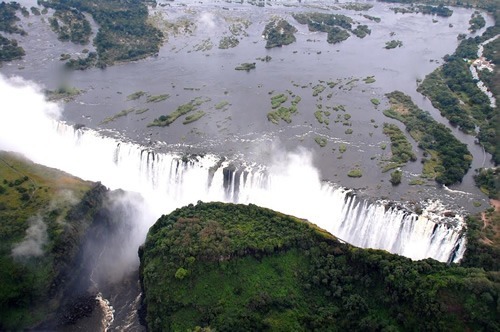 |
| Victoria Falls on the border of Zimbabwe and Zambia. |
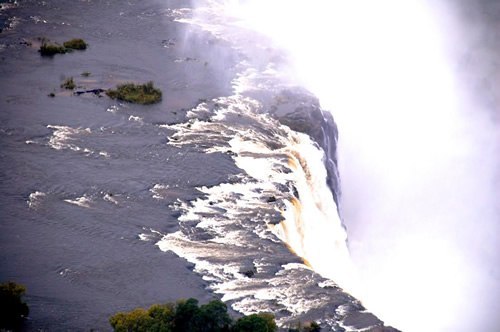 |
| Victoria Falls from yet another spectacular angle. |
Flying like a bird above the falls during a 13-minute helicopter ride is certainly pricey for a budget traveler, but this is a once-in-a-lifetime experience, well worth the extra 150 bucks. The breathtaking view from the air gives a totally different perspective of the mighty Zambezi River, the falls, gorges, rainforest, and surrounding area. After driving more than 5,000 km along so many impressive sites and sights in less than 20 days, this UNESCO World Heritage Site, especially from above, is undoubtedly the sparkling icing on an already monumental cake!
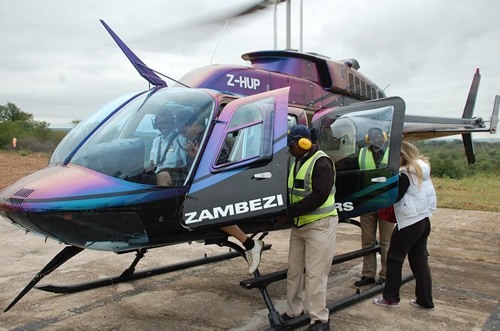 |
| Taking a helicopter ride over Victoria Falls is well worth the expense. |
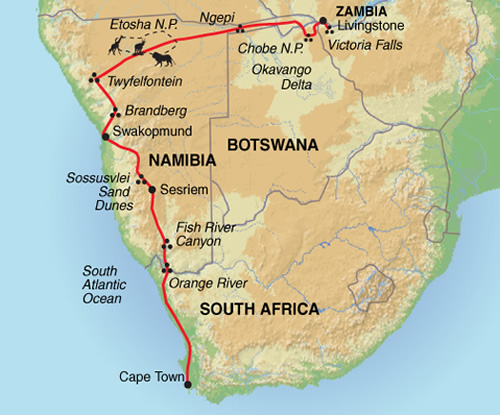 |
| A map from Exodus depicts the memorable journey we took through Southern Africa. |
Trip Notes
on Southern African
- The trip is organized by Exodus
-
Costs varies by season (from $4200-$6800) and includes all meals, transportation, and accommodation (2 nights lodge and 2 nights guesthouse, 15 nights camping in 2-person tents) for the Capetown to Victoria Falls Camping Exodus tour. Always check tour for any pricing and itinerary updates.
-
Most camping sites are clean and have facilities of reasonable standard, but only a few have WiFi
- All camping gear is provided, including thick foam mattresses and folding stools, but one needs to bring an own sleeping bag
- Driving distances can be long and should not be underestimated
-
Daily rotation in the truck gives everyone a fair chance to have a window or front seat at times. During the game drives, the windows can be pushed down for better views and to take pictures.
|
Lies Ouwerkerk is originally from Amsterdam, The Netherlands, and currently lives in Montreal, Canada. Previously a columnist for The Sherbrooke Record, she is presently a freelance writer and photographer for various travel magazines.
|
